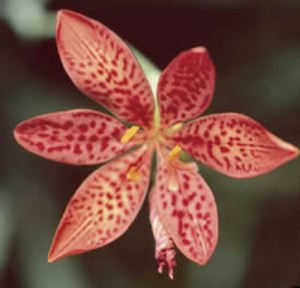Spring is the time to enjoy all of those hardy bulbs that were planted in the fall. The crocus, hyacinths, daffodils and tulips put on their gorgeous show and then disappear until next spring. But spring is not the only time to enjoy bulbs, since they flower in almost every season. There are several hardy summer bulbs that can be planted in the spring. They will flower a short while later in the season.
These are hardy summer bulbs and not to be confused with the tender bulbs. Hardy summer bulbs can withstand freezing temperatures and can be left in the ground or container during winter. Many hardy summer bulbs are actually rhizomes, tubers or corms. They all fall under the classification of geophytes, but this term is rarely used by gardeners.
This list contains hardy summer bulbs to plant in the spring for summer and autumn bloom. They can be planted later in the season as well, just don’t expect them to flower with certainty. Sometimes packages of hardy summer bulbs, tubers, corms and rhizomes can be found after the peak planting season has passed. The price is often discounted and this is a great way to try unusual varieties of these hardy bulbs without spending much. As long as the leaves are left in place and the plant is otherwise healthy, patience will reward you with blossoms the next year.
Blackberry Lily (Belamcanda chinensis)
This is not a true lily and it’s not a true bulb. It’s a tough member of the Iris family and grows by rhizomes. The Blackberry Lily gets its nickname from the black seed pods that form following the flowers. It’s a good choice for spring planting, but don’t plant it deep. Just like the Irises’ rhizome, these must be planted just barely below the soil surface.
The leaves of the Blackberry Lily look similar to those of the Iris. The Blackberry Lily blooms in the summer on tall stalks that are 2 to3-feet tall. The flowers are most commonly available in yellow, orange and yellow speckled, or red. This plant is not particular about soil and is heat and drought-tolerant. It’s best to give adequate water when it’s actively growing, but do not over water.
This hardy summer plant reaches 15 to 18-inches tall. It can bloom early or midsummer and early autumn. Parts of the plant and the seeds are poisonous if ingested. Hardy in USDA Zones 4 to 10 (photo 1)
Chinese Ground Orchid (Bletilla striata)
Plant this hardy bulb early in the early spring for a late spring flower show. This exotic beauty grows by rhizomes and is indeed a member of the orchid family. It blooms white or pinkish-purple flowers on 2-foot tall stalks for about two weeks. It must have protection from hot afternoon sun, but it needs adequate morning sun. This hardy summer bulb grows to about 12- 18-inches tall.
The Chinese Ground Orchid should be planted in a soil with rich organic matter, either natural or amended by the gardener. The soil needs to be kept moist, but not soggy. Even after the flowering stops, it still needs to be kept moist. Plant the little rhizomes about 4-inches deep. Choose the area carefully for this hardy plant so it can slowly spread and colonize. The planting sight should be heavily mulched with several inches for winter protection. Hardy in USDA Zones 5 to 9 (only marginally hardy in zone 5) (photo 2)
Lily-of-the-Valley (Convallaria majalis)
This hardy plant will slowly spread by its underground rhizomes. Lily-of-the-Valley blooms in the spring with petite fragrant white blossoms. This plant is definitely cold hardy and tough. It does require partial shade in order to do its best and can tolerate full shade quite easily. In cooler northern regions, it can survive in a sunnier location. Plant these little rhizomes (often referred to as “pips”) as early as possible in the spring to give them a good start. Plant them about an inch deep.
Lily-of-the-Valley is a good companion for other early flowering spring bulbs. The Lily-of-the-Valley foliage helps to conceal the withering foliage of bulbs like daffodils and tulips. Since this hardy rhizome does spread, it is used as a ground cover. The leaves can reach almost 8 inches in height. Give Lily-of-the-Valley water during times of heat and drought. Hardy in USDA Zones 2 to 7 (all parts of the plant are poisonous if ingested) (See my article “Lily-of-the-Valley is a Hardy Shade Loving Perennial” for a photo.)
Hardy Cyclamen (C. Hederifolium)
Cyclamens are pretty and dainty little plants to have, but a hardy cyclamen is an unexpected treasure. There is several varieties of Cyclamen and not all are hardy. This C. Hederifolium is reliably hardy as far north as zone five. They are excellent shade plants that grow from corms and produce unusual fragrant flowers that rise above the foliage. Cyclamen bloom in late summer to early autumn in pink or white and look right at home in a woodland setting.
Sometimes there isn’t a lot of foliage to accompany the blossoms, which almost appear suspended in the air like butterflies. The flowers appear on slender stalks that rise from the corm about 6-inches tall and sometimes reach almost 12-inches tall. When the foliage does appear, it is as lovely as the tender florist’s cyclamens. The oval to round leaves can be serrated or smooth, and are often variegated or speckled with silver or gray. Hardy Cyclamen should be planted in light shade in moist soil. They will also self-sow after flowering, so deadhead the flowers if volunteer seedlings aren’t wanted. Hardy USDA Zones 5 to 9 (photo 3)
Iris
This is a diverse classification of plants. Several Irises are grown from bulbs and many of the popular varieties are grown from rhizomes. Well-loved Bearded Iris is rhizomatous and puts on a beautiful floral show in late spring or early summer. This hardy plant has attractive sword-like foliage that is pretty, even when the plant is not in bloom. This popular Bearded Iris is available in almost every color imaginable, with the exception of true blue. The flowers are spectacular and make great cut flowers to enjoy indoors.
The Iris’ rhizome should be planted just at the soil surface. They will not do well if planted too deep. Keep the rhizomes watered when they are first planted. After they are growing and established, Iris is drought-tolerant and tough. There is new varieties of Iris being introduced regularly and some will have variances in bloom time and some types even rebloom. Iris can fill in an area quite rapidly, so plan on dividing the rhizomes about 3 to 4 years after planting. Divide them after they finish blooming and share them with a friend or fill in bare spots in the garden. Hardy in USDA Zones 4 to 9 (photo 4)
Lily (Lilium)
This is a true bulb and the real deal Lily. It seems there are so many plants that use the name Lily as part of their common name, it is sometimes difficult for the home gardener to distinguish between a real Lily and an imposter. This is a true hardy bulb and can be planted in the spring or anytime after the ground is warm. There is almost one hundred varieties of this beautiful and fragrant flower. Some grow only 12-inches tall, while other Lilies can reach several feet tall. Just know what type of Lily bulb you are getting. Several of these hardy bulbs are the extremely fragrant varieties.
There are Lilies that bloom in early summer and others in the early fall. Some of these hardy bulbs can bloom for over a month. They all make great cut flowers, just beware of their stamens that protrude from the center of the flower. The rusty-colored pollen drops easily and can stain fabrics. It’s best to snip the stamens off the flowers when using them in arrangements. The USDA Zones vary for different Lilies. Lily bulbs are cold hard and can be left to overwinter in the ground in all but extreme northern zones. Several varieties are hardy as far north as USDA Zone 3 and 4, just know what type you’re planting. (photo 5)






